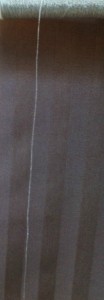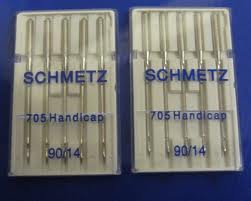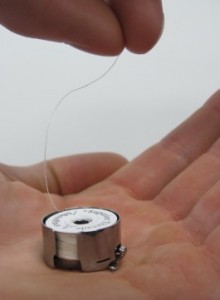Do you know why we buy this thread? It’s pretty. We gaze at the shimmery colors and imagine all the wonderful embellishments we can make on our next quilt using this beautiful thread. It is also a favorite for use in decorative machine embroidery. We take it home, thread it through the sewing machine, and then the trouble starts. The thread frays. The thread breaks. It gets snagged in the thread path of the machine. So what is the secret to making this thread behave?
When you find a metallic thread you like, unroll approximately 12 inches of the thread from the spool and let it dangle. Does it hang fairly straight, with just the slightest bend in it? That’s a good sign.
Does it hang in coils and will not relax? That’s a bad sign. Metallic threads that are wound on tiny spools tend to coil and will not relax. This means the thread is going to twist while it runs through the thread path of the machine and will likely break before it gets to the needle. Look for metallic thread that is wound on larger spools and that hangs fairly straight when unrolled from the spool.
The best needle for metallic threads is a size 90/14 Topstitch Needle. These needles are easy to find and fit almost any sewing machine. They have a larger, elongated eye and have an extra deep groove in the needle shaft that allows the thread to travel down and through the needle more easily, preventing fraying and breaking.
When you are using a metallic thread on the top of the machine, use a 60-weight thread in the bobbin. This thread is slightly thinner than a standard 50-weight piecing thread so it will be less bulky when catching the metallic thread and holding it to the surface of the stitch.
Decrease your top tension. When you decrease the top tension, you are widening the space between the two tension plates in the sewing machine. This allows more space for the thread to travel through and puts less tension on the thread itself. Metallic threads are made by wrapping microscopically thin sheets of aluminum around a cotton core. If too much tension is placed on the metal, it will start to unwrap from the core and fray, and then break.
If you have tried all of the above steps and the thread still appears to be too tight going through the needle, skip the last thread guide (the one closest to the needle). This will frequently take just enough tension off the thread for it to relax and run through the needle successfully.
Avoid the frustrations that can occur when using metallic threads by making some simple adjustments to your sewing machine, using the right needle and the right thread in your bobbin.
Until next time,
Joan
SEWING WITH METALLIC THREAD





Thank you so much for this information!